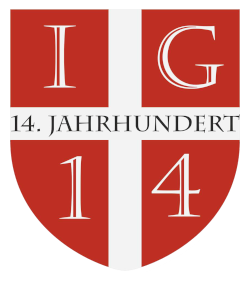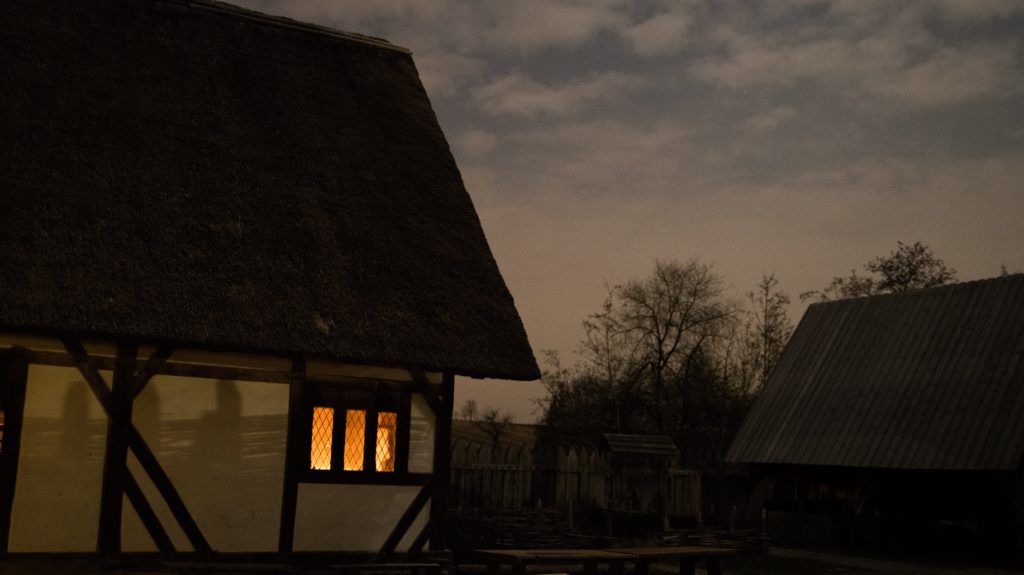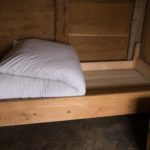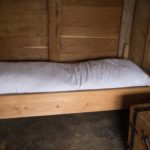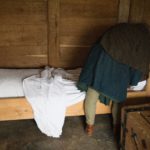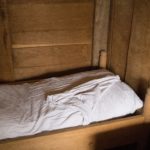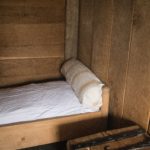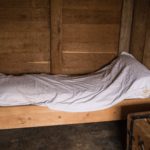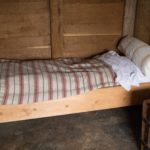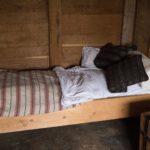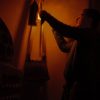Sleeping habits and Beds in late medieval times
When finished with costumes and the daily life equipment for our hobby, other topics become more important when preparing concepts for events. In the future, we would like to take a closer look on the details of late medieval life styles and recreate them as far as possible. This includes for example sleeping habits and routines.
Of bi-phase sleep rythms
In the monasteries of high and late medieval times, a strict structure of daily life was the rule. After the ‘complet’, the last prayer of the day, the monks and nuns went to bed and slept until the ‘vigil’, the night time prayer which was usually held at the 8th hour of the night, so around 2 o’clock in the morning. After that, they returned back to bed until the ‘laudes’, the morning prayer, often held at around 6 o’clock or at sunrise.
The normal man of course was not obligated to keep to that structure, but we can find several sources that tell us that medieval society saw it as virtuous to follow the example of monastery life and rise once in the night, say a prayer and go back to bed.
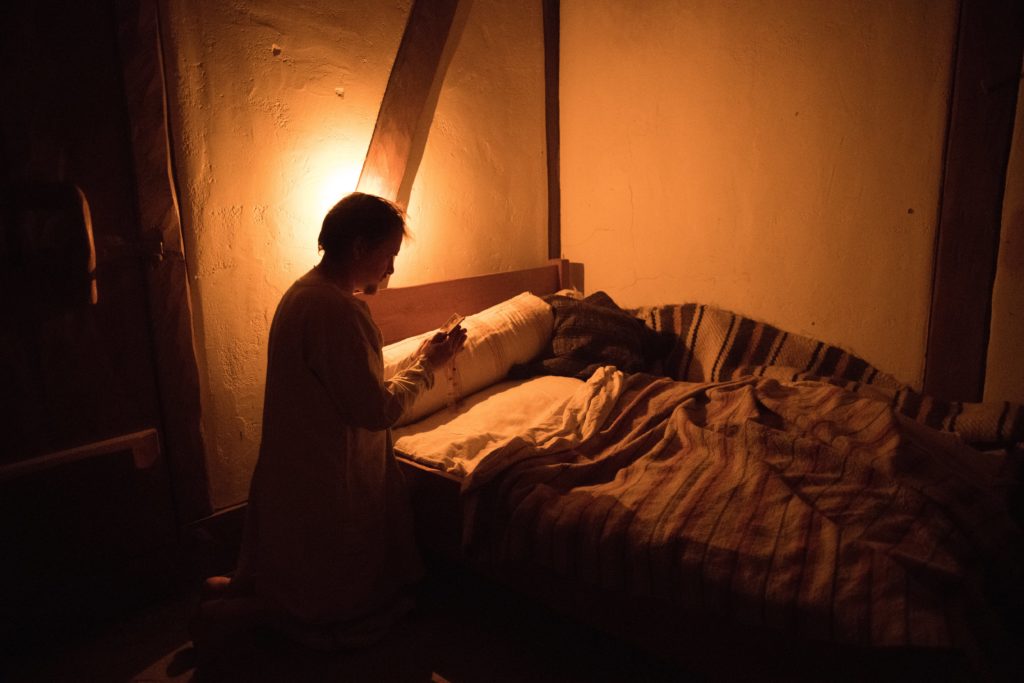
This particular sleeping rythm is quite interesting and it is worth noting that it is not merely an invention of the forefathers of the church, but it is rather corresponding to natural sleeping habits of pre-industrial society. The invention of artificial lighting and with it the extension of the timeframe in which we are exposed to light per day, has had a lasting effect on our sleeping habits. People in pre-industrial societies were exposed to far less light and far less blue tinted light, were naturally inclined to sleep in two 4-hour phases during the night.
Inbetween, they could pray, have sex or just follow some household tasks.
In many cities it was not, however, permitted to work in your profession during the night (between sundown and sunrise). This was a measure taken to provide a certain quality of the goods, because they were made in sufficient lighting. On the other hand it also served as a regulation for working hours and this was important for a stable competitive environment between crafters of a guild. It also was an important measure to keep illicit work (still called “moonlight work” today) and the production of goods not permitted for a certain profession to a minimum and helped with the nightly noise ordinance and fire protection. Bakeries often had a special permit to work during the night since obviously, their working hours have to be at night.
Often, a bell would signal the end of the daily working time. In Vienna for example, we know of the Beer-bell (‘pirglocke’), that rang in the nighttime and ended the tavern opening hours in the 14th and 15th century.
The Menagier of Paris describes the bi-phasic sleep as very virtuous:
“You must arise in the morning – and morning means, with regard to the subject we are treating here, Matins. For just as we country folk describe the day as from dawn to night or from sunrise to sunset, clerks who are more subtle say that ist he artificial day, and that the natural day is 24 hours long and begins at midnight and ends at the following midnight. So that is why I explaned that morning refers to matins. I mention it because the Matins bell rings then to wake up the monks to say the Matins and praise God, and not at all because I wish to imply that you, dear one, or any married women, must get up at that hour. But I do want to have pointed it out, so that at the hour that you hear the Matins ringing, you praise and hail our Lord with some greeting or prayer before you fall back to sleep. To this purpose, proper orisons or prayers are included below. For either the hour of Matins or at daybreak, I have written down two prayers for you to adress our Lord and two others for our Lady, appropriate to say when waking up or arising from bed.”
So the author talks about getting up shortly for the Vigil or Matutin/Matins and then rising for the day at Laudes, the morning prayer. Today, the morning is still called “matin” in french.
A very interesting article on the phenomenon of biphasic sleeping can be found here.
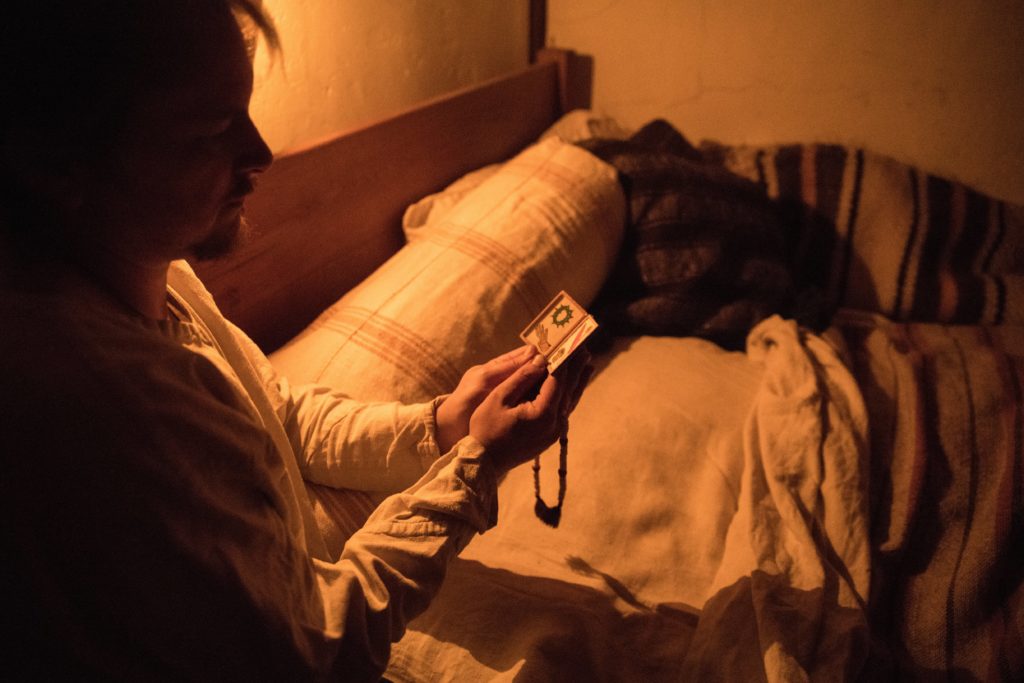
Of getting up early
Going to bed early and rising early was considered a virtuous lifestyle in late medieval Austria. Heinrich der Teichner writes:
Daz man gern sol frue auf stan: so hat ein mensch die grozzen er von dem suessen got enphang und slaft doch nymmer ein tir so lang als der mensch slaffen tuet, daz auf erden lebt und pluet, daz ist dezs morgens diensthaft und in seiner pesten chraft. […] waz auf erden leben chan, daz furcht unsers herren pan smorgens harter denn gein abent. weil all priester mez habent gotez marter zu aim pild, so ist nyndert ain dinch so wild, ez hab die selben zeit in eren. da pey solt der mensch leren und prach seim slaff ab smorgens, weil man mezz hab. […] frue auf stan daz ist gesund nach dem leib nu mercht eben: man siecht nieman so lang leben als chloster laeut, muenich und nunn: die habent sich der mazz besunn, si legent sich zu rechter vrist und stent dann auf, als pilleich ist, so man got loben sol. daz gezimpt dem leib wol und behalt du sel dermit.
And also the Menagier de Paris has a full chapter on getting up early and praises the diligent that rise with the sun.
Who sleeps how?
What the bed of a medieval person looked like was strongly dependant from the size of his purse. We know of farmhands that had to sleep on benches in the parlor of the house, just with a small pillow and a blanket. Original pictures and texts show us that monks that were practicing abstinence, could sleep on simple straw- or rush mats on the floor, covered with a blanket and resting on a pillow. Also a straw sack could be a simple form of a bed.
Crafters and higher classes would sleep in proper beds however. It was not unusual to share beds with other members of the family and the marital bed was often not the only bed in the sleeping chamber.
And again, the size of their purse would decide how comfortable these beds were. From a simple long straw matress to feather or hair filling and from a simple woolen blanket to featherbeds and pelt-lined silk blankets, a wide range of bedding was available. We often see heavy curtains embellished the outsides of the beds of higher classes in order to keep the warmth inside and unwanted gazes outside.
Bedding was part of wills regularly. Important heirs would receive the “gute Ziechen” and less important ones the elder, used beddings. So bedding was one of the more important parts of the household. It is often a part of the dowry of a bride.
Please see the articles down below on more details on the contents of the bed.
The bed
The single components of beds can be recreated from many textual and pictural sources. The following set up is common:
- In den Bettrahmen (dieser kann wie hier mit vollem Boden, aber auch zb mit Spanngurten oder Seilen gefertigt sein) kommt zuerst der Strohsack…
- …gut gefüllt mit Langstroh, Heu oder Wurmfarn, aber beispielsweise auch Haar, Wolle oder echte Federn können je nach Geldbeutel die Füllung stellen. Manche Quellen beschreiben auch,dass das Heu einfach nur in den Rahmen geschüttet wird, ohne Matratzensack drum herum.
- Darüber legt unser Knecht das erste Leintuch…
- …das die Matratze vor Schmutz und Schweiß bewahren soll und einen zusätzlichen Schutz gegen durchpieksende Halme liefert.
- Die Kissenrolle bildet die Basis des Kopfendes. Dazu haben wir auch einen extra Artikel auf diesem Blog (siehe Verlinkungen am Ende des Artikels)
- Ein weiteres Laken soll die darüber gelegte Bettdecke vor Schweiß und Schmutz schützen, eine Technik wie wir sie heute zB noch in Amerika oder im Südeuropäischen Raum finden.
- Die darüber gelegte Decke ist meist gewoben und weist oft Streifenmuster auf, aber wir wissen aus Textquellen auch von Federbetten (Tuchenden), die mehr Wärme und Komfort liefern können.
- den Abschluss bilden oft mehrere kleinere Kopfkissen, gefüllt mit Stroh, Heu, Daunen oder Haar und oft mit einem gemusterten Überzug und Quasten an den Ecken.
Hygiene and vermin in the bed
The filling of matresses (and beds) was regularly changed. In better households up to 4 times a year, but even in simpler households at least once a year. The linnens could be washed at cooking temperatures and they often appear in late medieval pictures of wash days as one of the most common washing goods. So a certain standard of hygiene could be held.
Vermin was treated with many different methods. For example boards coated with skin glue and strong smelling substances (f.e. coriander water). Moskitos and flies were also a common enemy in the bed chamber and the Menagier de Paris teaches us several methodes to get rid of them, f.e. moskito netting or simply fly swats and sticks covered in skin glue.
For more information:
Die Nacht im Mittelalter – Tzotcho Boiadjiev, Übersetzung von Barbara Müller, 2003
The Goodwife’s Guide – Le Menagier de Paris
Ein moderner Blick auf den biphasischen Schlaf
Segmented Sleep in Preindustrial Societies
Between the Sheets: Reading Beds and Chambers in Late-Medieval England
Sleeping medieval – Monks, nuns and monastic knights
Sleeping medieval – Soldiers, knights and travellers
Ferdinand Opll – Leben im mittelalterlichen Wien
Harry Kühnel – Alltag im Spätmittelalter
Medieval household pest control
Related Posts
The following posts might interest you as well:

